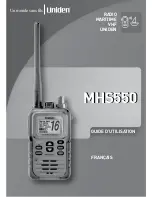
Operating Manual 6175.4760.02 – 01
5.9
M3SR Series 4100
Types of GPS Transmission
The maximum configurable number of GPS reporting participants has been limited in
R&S RNMS3000 to 32 participants. Thus, the network is occupied by GPS traffic for maxi-
mally 32 seconds, assuming all participants transmit their position information sequentially
scheduled (one after each other) in a scheduling round.
Based on a common GPS time reference, the scheduling scheme gives each participant an
exclusive slot access right once per scheduling round.
By binding the right to transmit GPS information to one exclusive scheduling slot, on-air col-
lisions between scheduled GPS data and control may be avoided. On the other hand, a GPS
participant has to wait until its assigned scheduling slot is due before it can transmit. In
SECOM-P and SECOM-V, the maximum number of GPS participants is limited to 32 partic-
ipants resulting in a worst case transmission delay (i.e. a “waiting time”) of 31 seconds.
In order to use the scheduling scheme, after entering a preset page supporting GPS report-
ing, any GPS participant must have received the GPS time signal at least once in order to
“synchronize” its scheduling algorithm with the other participants. If the GPS time signal re-
ception is temporarily limited or lost, a back-up clock will maintain the synchronism.
However, if the GPS time signal has never been received after entering the preset page, the
participant cannot support scheduled GPS transmissions (see sect. 5.2.1.4 General Re-
quirements and Valid Combinations of GPS Reporting Features).
Immediate (Unscheduled) Transmission
Immediate GPS transmissions are sent immediately, i.e. without using the scheduling
scheme (see ”Standard (Scheduled) Transmission” on p. 5.8). Hence, there is some poten-
tial that any non-scheduled transmission conflicts on-air with other (scheduled or non-sched-
uled) GPS transmissions and cannot be received by other GPS participants.
On the other hand, an immediate GPS transmission is executed without any scheduling de-
lay and the GPS time signal reception is not required for synchronizing the scheduling trans-
missions with other GPS participants.
Therefore immediate GPS transmissions should be used in situations when a delay in trans-
mitting GPS data or control cannot be accepted or in case the GPS time signal (required for
scheduling) has never been received before (after entering the preset page).
Summary of Contents for M3SR 4100 Series
Page 15: ...M3SR Series 4100 Documentation Overview xiv Operating Manual 6175 4760 02 01...
Page 48: ...M3SR Series 4100 Index 34 Operating Manual 6175 4760 02 01 ZF4401 mod 02 2 10...
Page 70: ...M3SR Series 4100 Radio Control 1 22 Operating Manual 6175 4760 02 01...
Page 116: ...M3SR Series 4100 Example Configuration 2 46 Operating Manual 6175 4760 02 01...
Page 336: ...M3SR Series 4100 Priority Channel 3 220 Operating Manual 6175 4760 02 01...
Page 696: ...M3SR Series 4100 Remote Control 8 4 Operating Manual 6175 4760 02 01...
Page 697: ...Operating Manual 6175 4760 02 01 9 1 M3SR Series 4100 Drawings 9 Drawings...
Page 706: ...M3SR Series 4100 Drawings 9 10 Operating Manual 6175 4760 02 01...















































